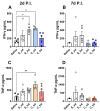Cell-Cultured Influenza Vaccine Enhances IFN-γ+ T Cell and Memory T Cell Responses Following A/Victoria/2570/2019 IVR-215 (A/H1N1) Infection
- PMID: 39772053
- PMCID: PMC11680451
- DOI: 10.3390/vaccines12121392
Cell-Cultured Influenza Vaccine Enhances IFN-γ+ T Cell and Memory T Cell Responses Following A/Victoria/2570/2019 IVR-215 (A/H1N1) Infection
Abstract
Background: Influenza remains a significant public health challenge, with vaccination being a substantial way to prevent it. Cell-cultured influenza vaccines have emerged to improve on the drawbacks of egg-based vaccines, but there are few studies focusing on T cell immunity with both types of vaccines. Therefore, we studied the following 2022-2023 seasonal influenza vaccines with a standard dose and high dose: cell-based (C_sd and C_hd) and egg-based (E_sd and E_hd) vaccines.
Methods: Along with a saline control group, C_sd, C_hd, E_sd, and E_hd vaccines were administered to BALB/c mice, followed by a challenge with the A/Victoria/2570/2019 (H1N1) strain.
Results: After the challenge, four out of five mice in the saline group died by day 7 post-infection (P.I.). None of the vaccinated groups experienced over 20% weight loss or any deaths. On day 7 P.I., the lung viral load in the saline group (mean log value of 4.17) was higher than that in the vaccinated groups, with the C_sd group showing the lowest viral load (mean log value of 3.47). The C_sd group showed a significantly high response in macrophage 1 (M1), IFN-γ+ T cells, and tissue-resident memory (TRM) T cells compared with the E_sd group on day 2 P.I. These M1, IFN-γ+ T cells, and TRM cells showed similar trends (p < 0.01). In terms of humoral immunity, only the E_hd group showed HAI titers above 40 for all four strains before and after the challenge.
Conclusions: The high levels of T cells in the cell-cultured vaccines suggest, pending further real-world research, that these vaccines may offer advantages.
Keywords: T cells in influenza vaccine immunity; cell-cultured influenza vaccine; egg-based influenza vaccine; immune cells in influenza vaccine immunity; influenza vaccine efficacy.
Conflict of interest statement
P.-K.K., K.-M.J. and J.-Y.J. are employees of SK Bioscience. While every effort has been made to ensure the integrity and objectivity of the research, the potential for perceived or actual conflicts of interest exists.
Figures





Similar articles
-
Safety, tolerability, and immunogenicity of influenza vaccination with a high-density microarray patch: Results from a randomized, controlled phase I clinical trial.PLoS Med. 2020 Mar 17;17(3):e1003024. doi: 10.1371/journal.pmed.1003024. eCollection 2020 Mar. PLoS Med. 2020. PMID: 32181756 Free PMC article. Clinical Trial.
-
Cross-protective immunity against influenza A/H1N1 virus challenge in mice immunized with recombinant vaccine expressing HA gene of influenza A/H5N1 virus.Virol J. 2013 Sep 22;10:291. doi: 10.1186/1743-422X-10-291. Virol J. 2013. PMID: 24053449 Free PMC article.
-
Influenza vaccine-mediated protection in older adults: Impact of influenza infection, cytomegalovirus serostatus and vaccine dosage.Exp Gerontol. 2018 Jul 1;107:116-125. doi: 10.1016/j.exger.2017.09.015. Epub 2017 Sep 27. Exp Gerontol. 2018. PMID: 28958701 Free PMC article. Clinical Trial.
-
A new adjuvanted nanoparticle-based H1N1 influenza vaccine induced antigen-specific local mucosal and systemic immune responses after administration into the lung.Vaccine. 2014 May 30;32(26):3216-22. doi: 10.1016/j.vaccine.2014.04.011. Epub 2014 Apr 13. Vaccine. 2014. PMID: 24731807
-
Serologic response to sequential vaccination with enhanced influenza vaccines: Open label randomized trial among adults aged 65-74 years.Vaccine. 2021 Dec 3;39(49):7146-7152. doi: 10.1016/j.vaccine.2021.10.072. Epub 2021 Nov 10. Vaccine. 2021. PMID: 34774360 Clinical Trial.
References
-
- Dawood F.S., Iuliano A.D., Reed C., Meltzer M.I., Shay D.K., Cheng P.-Y., Bandaranayake D., Breiman R.F., Brooks W.A., Buchy P., et al. Estimated global mortality associated with the first 12 months of 2009 pandemic influenza A H1N1 virus circulation: A modelling study. Lancet Infect. Dis. 2012;12:687–695. doi: 10.1016/S1473-3099(12)70121-4. - DOI - PubMed
Grants and funding
LinkOut - more resources
Full Text Sources

